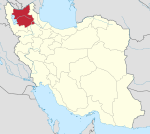Kaleybar
Kaleybar (Persian: كليبر) (Azerbaijani: كليبر); also Romanized as Kalībar, Kalipar, Keleibar, and Keleivar)[2] is a city and capital of Kaleybar County, East Azerbaijan Province, Iran. According to the 2006 census, Kaleybar, with a population of 9,030 in 2,397 families, is the 25th most populated city of the province.[3] In recent year the city has become a tourist destination thanks to its proximity to Babak Castle. In addition, as a result of geopolitical developments Kaleybar is gradually replacing Ahar as the capital city of Qareh Dagh region.
Kaleybar كليبر | |
|---|---|
City | |
 Kaleybar in May 2013 | |
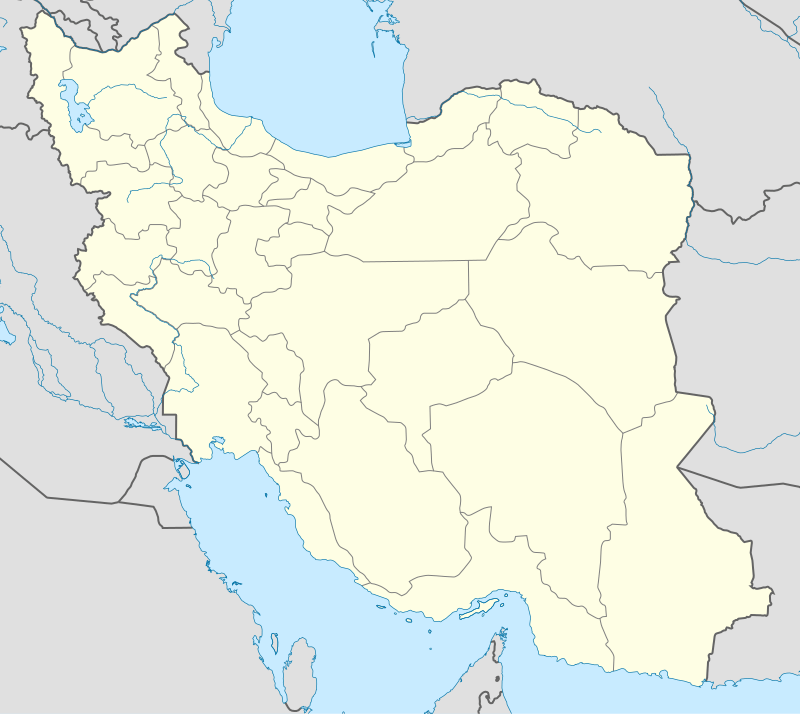 Kaleybar | |
| Coordinates: 38°52′10″N 47°02′08″E | |
| Country | |
| Province | East Azerbaijan |
| County | Kaleybar |
| Bakhsh | Central |
| Population (2016 Census) | |
| • Total | 9,324 [1] |
| Time zone | UTC+3:30 (IRST) |
| • Summer (DST) | UTC+4:30 (IRDT) |
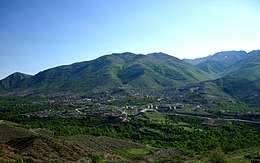
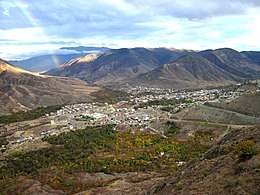

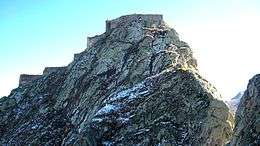





History
Kaleybar, known as Badd or Baddayn (or Bedh) in Islamic chronicles,[4] was the stronghold of Babak Khorramdin[5] who, in 816 AD, revolted against Islamic Caliphate. Babak's resistance was ended in 836 when he was defeated by the Iranian General Afshin,[6] acting on behalf of the Caliphate.[7] The events of the two decades long tumultuous times subjected the town to the reports of early Islamic historians.
The first reference to Kaleybar has been by Al-Masudi in The Meadows of Gold, Babak revolted in Bedh region with the deciples of Djavidan ...[8] Following a series of defeats Babak was blockaded in his native town..., which even now is known as Babak's country.[9]
Ibn Athir in his book, The Complete History, has devoted many pages to the description of battles which took place in Kaleybar between the Armies of Caliphate and Babak's forces.[10]
Yaqut al-Hamawi, writing in early thirteenth century, describes Kaleybar as the following, County between Azerbaijan and Erran. This is where Babek resisted when he rebelled against Mo'taçem. We know these verses Bokhteri
God protects you, great warrior who, in the days of Babak, have reversed the doors of the ungodly;
It is you who have taken their city Bedh that you covered the shamelessness in it.
There was a near Bedd, says the poet Mo'çer, a place of an area of about three acres, every time we say the name of God, a hidden voice responds. This is where the Red-Wearing Ones, also called the Khurramites raised the standard of revolt led by Babak ', this is also they expect EI-Mehdi. At the bottom, flows a large river which has the property of curing the most inveterate fevers. The Arax river flows on the border. This county produces pomegranates of incomparable beauty, excellent figs and grapes that are dried on fires (because the sun is always obscured by thick clouds). [11]
Hamdallah Mustawfi, writing in mid fourteenth century, mentions Kaleybar as, A village of Azerbaijan, in the woods near a mountain which comprises a fortress. Below flows a river. The country produces wheat and fruit, and its inhabitants, who are Turks or Mongols, follow the rite of Schafey.[12][13]
Kaleybar, perhaps, suffered enormously during Russo-Persian War (1804–13) and Russo-Persian War (1826–28) due to its proximity to the war zone. Moreover, through the involvement of Arasbaran tribes in armed conflicts during the Persian Constitutional Revolution, Kaleybar should have experienced a tumultuous period. The period has been described in the following books, which are dedicated to the contemporary history of Arasbaran region.
Culture
Rezā Shāh, who deposed Ahmad Shah Qajar in 1925 and founded the Pahlavi dynasty, insisted on ethnic nationalism and cultural Unitarianism and implemented his policies with forced sedentarization of nomadic tribes. He renamed Qaradağ as Arasbaran to deny the Turkic identity of the inhabitants.[19] In recent years, as a reaction to this oppressive acts, there has been an identity-seeking movement which emphasizes on the heroic resistance of Babak. In 1998-2006 period Babak Castle considered a shrine for the movement [20] and many cultural events were organized near Kaleybar.
Religion
The dominant religion is Shia Islam. However, followers of Yârsân or Ahl-e Haqq constitute an appreciable minority in the town and the surrounding villages. Dr. Mohamad Ali, the only physician of the town until the 1970s, was a member of Bahaii faith.
Language
The spoken language in Kaleybar is the Azeri dialect of Turkish. Tough, until late seventies the older residents of some neighboring villages (Çaykändi, Kälasor, Xuynärod, Arazin) spoke Tati language,[21] there is no evidence that Tati was ever spoken in Kaleybar. A cleric, the late Haji Mohammad Zakeri, told that the name Kaleybar was indeed a Tati word, meaning a town built on rocks. Kaleybar region with mountainous terrain, shepherding and cultivation of hillside possess the isolating features for the development of a sophisticated whistled language.[22] The majority of males are able, and perhaps addicted, to masterfully mimic the melodic sounds of musical instruments using fingerless whistle.Melodic whistling, indeed, appears to be a private version of the Ashug music for personal satisfaction.
Ashugh music
The mountainous region of Qaradağ, due to its remoteness and inaccessibility, was a guardian of Ashugh music. This frequent allusions of this music to mountains, with the intention of arousing an emotional state with a tone of mild melancholy, is consistent with the geography of Kaleybar. The first verses of an Ashugh song, composed by Məhəmməd Araz, may represent the essence of Ashugh music:
Bəlkə bu yerlərə birdə gəlmədim (I may not come to these places again)
duman səlamət qal dağ səlamət qal (Farewell to the Mist and to the mountain)
arxamca su səpir göydə bulutlar (Behind me the clouds sprinkle drops of rain)
leysan səlamət qal yağ səlamət qal (Farewell to summer days, farewell to the rain)
Aşıq Hoseyn Javan, born in Oti Kandi near Kaleybar, is the legendary Ashik who was exiled to Soviet Union due to his revolutionary songs during the brief reign of Azerbaijan People's Government following the World War II. Hoseyn Javan's music, in contrast to the contemporary poetry in Iran, emphasizes on realism and beauties of real life in line with the mainstream world view of Arasbaran culture.
Potential for tourism
James Morier, the author of "The Adventures of Hajji Baba of Ispahan",[23] travelling through Kaleybar in early 19th century described the city in the following words, "Kaleybar... was formerly a considerable place. Its extensive gardens have become a forest of fruit-trees, where the walnuts grow to an immense size..."[24] More recently, Jamie Maslin, a Canadian traveler write, " ... was surrounded by steep green mountains, the peaks of which remained unseen, shrouded in a slowly drifting mountain mist. It was a great location and once again so very different from most people's perception of Iran - not dry and parched like its central deserts, but as lush and green as merry old mother England."[25]
Zoğal Festival
The micro-climate, generated by the surrounding mountains, is particularly suited for the production of zoğal (Cornus mas, Persian: زغال اخته, Turkish:Kızılcık). The berries, which ripen in mid to late summer, are sold in numerous small shops alongside the Shahid Ansari Street. The smell of fermenting dark ruby-red fruits and the sight of menacing wasps perching on them is a vivid mental imagery a tourist may get as a lifelong pleasant impression. The local, though, would cherish the landscape of their town mingled with the vivid yellow blossoming zoğal trees in early spring.
The surplus berries will be sun-dried on flat roof tops and sold to the market as an ingredient of Erişte Aşı (Persian: آش رشته). Unfortunately, the local version of this thick soup is not offered in restaurants.
In recent years, the local government has organized Zoğal festivals as a means of promoting tourism.[26]
Babak Castle
The relatively well preserved Babak Castle at an altitude of 2300 m is located is located some 3 km of the town. This Sasanid era fortress is named after the ninth century Iranian resistance leader, Babak Khorramdin.,[27] who resisted Arab armies until year 839.[28]
summer camp of Arasbaran Tribes
The mountain ranges south-west of Kaleybar are still used as summer camp of pastoralists belonging to Arasbaran Tribes. This provides an opportunity for observing the relaxed idyllic life style of bygone times. Pastoralists, despite their simple life style during summer months, are often well-educated folks and own modern dwelling in their winter quarters. They, generally, welcome visitors as long as their cultures and mode of life is not ridiculed. The visit should me made on sunny days when the shepherd dogs feel lethargic. During foggy days and between dusk and down dogs regain their vicious character; strangers have to avoid crossing campsite otherwise the attacking dogs cannot be controlled even by their owners. Fending off the dogs by beating is considered an act of aggression towards the owner and should be avoided.
References
- https://www.amar.org.ir/english
- Kaleybar can be found at GEOnet Names Server, at this link, by opening the Advanced Search box, entering "-3069124" in the "Unique Feature Id" form, and clicking on "Search Database".
- "Census of the Islamic Republic of Iran, 1385 (2006)". Islamic Republic of Iran. Archived from the original (Excel) on 2011-11-11.
- "BAḎḎ". iranicaonline. Encyclopaedia Iranica. August 19, 2011.
- "BĀBAK ḴORRAMI". iranicaonline. Ecncyclopedia Iranica. August 18, 2011.
- "AFŠĪN". iranicaonline. Encycloppaedia Iranica. July 28, 2011.
- K. Farrokh, Iran at War: 1500-1988, 2011, Osprey Publishing
- ‘Alī ibn al-Husayn al- Mas‘Ūdī, Pavet de Courteille, Les Prairies d'or de Maçoudi, 1873, Paris, vol. 7, p. 62
- ‘Alī ibn al-Husayn al- Mas‘Ūdī, Pavet de Courteille, Les Prairies d'or de Maçoudi, 1873, Paris, vol. 7, p. 123
- عز الدین ابن اثیر، تاریخ کامل، ۱۳۸۱، تهران، جلد نهم، صص. ۳۹۸۲-۴۰۱۲.
- Yaqut ibn 'Abd Allah al-Rumi al-Hamawi, Charles Adrien Casimir Barbier de Meynard, Dictionnaire géographique, historique et littéraire de la Perse et des contrees adjacentes, 1851, Paris, pp. 87-88
- نزهةالقلوب ، حمداله مستوفی ، به کوشش محمد دبیر سیاقی ، انتشارات کتابخانه طهوری ، چاپ اول ، تهران ، ۱۳۳۶، ص. ۹۵.
- Yaqut ibn 'Abd Allah al-Rumi al-Hamawi, Charles Adrien Casimir Barbier de Meynard, Dictionnaire géographique, historique et littéraire de la Perse et des contrees adjacentes, 1851, Paris, p. 493
- سرهنگ حسین بایبوردی، "تاریخ ارسباران"، ابن سینا، تهران ۱۳۴۱
- حسین دوستی، تاریخ و جغرافیای ارسباران,انتشارات احرار,تبریز,1373
- ناصر صدقی،تاریخ اجتماعى و سیاسى ارسباران (قره داغ) در دوره معاصر، ۱۳۸۸، تبریز، نشر اختر.
- سیدرضا آلمحمد، نامه ارسباران، ۱۳۹۱، تهران، کتابخانه موزه و اسناد مجلس شورای اسلامی.
- Oberling, Pierre. "The Tribes of Qarāca Dāġ: A Brief History." Oriens 17 (1964): 60-95
- Abrahamian, Ervand (1982). Iran Between Two Revolutions. Princeton, New Jersey: Princeton University Press. pp. 123–163. ISBN 9780691053424. OCLC 7975938.
- Gilles Riaux, Ethnicité et nationalisme en Iran: la cause azerbaïdjanaise, KARTALA 2012, p. 246-
- E. Yarshater, Iranian Languages and Texts from Iran and Turan, edited by Maria Macuch, Mauro Maggi, Werner Sundermann, 2007, page 443.
- J.Meyer, Bioacoustics of human whistled languages: an alternative approach to thecognitive processes of language, Anais da Academia Brasileira de Ciências,76, 405-412, (2004)
- James Morier,The Adventures of Hajji Baba of Ispahan, 2005, Cosimo Inc.
- James Morier, A Second Journey through Persia, Armenia, and Asia Minor, to Constantinople ..., 1818, p.410
- Jamie Maslin, "Iranian Rappers and Persian Porn: A Hitchhiker's Adventures in the New Iran", 2009
- http://www.farsnews.com/newstext.php?nn=13920621000144
- Abbas Amanat and Farzin Vejdani (Editors),"Iran Facing Others: Identity Boundaries in a Historical Perspective", 2012 Palgrave Macmillan, Chap. 3.
- P. L. Baker and H. Smith, Iran, 2009, Bradet Trvel Guids, p. 141
External links
| Wikivoyage has a travel guide for Kaleybar. |
- "Kaleybar, Iran" Falling Rain Genomics, Inc.
| Wikimedia Commons has media related to Kaleybar. |
